- Last Updated: December 16th, 2025
Key Takeaways
PCB chemical testing is crucial for identifying and assessing the presence of harmful polychlorinated biphenyls (PCBs) in various mediums, such as soil, air, and building materials.
Technology advancements have improved PCB testing methods, including enhanced sensitivity, rapid processing, automation, and better data management.
Implementing proper protocols, thorough staff training, and addressing common challenges can ensure accurate and reliable PCB testing results while safeguarding human health and the environment.
Overview of PCB Testing
On this page, we’ll discuss the importance of PCB Testing, methods used to detect PCB contamination, the role of PCB testing in environmental monitoring and remediation efforts, and much more.
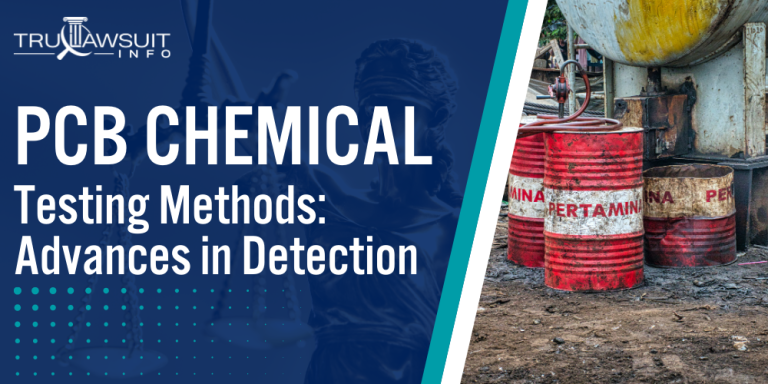
Intro to PCB Testing
Some of the key aspects of PCB testing include:
- Sampling Techniques: Proper sampling methods are critical to ensure representative and reliable PCB test results.
- Analytical Methods: Various analytical techniques, such as gas chromatography and mass spectrometry, detect and quantify PCBs in environmental samples.
- Quality Control: Stringent quality control measures are employed to ensure the accuracy and precision of PCB testing results.
- Interpretation of Results: PCB test results are interpreted in the context of regulatory standards and site-specific conditions to guide decision-making for remediation and risk assessment.
If you suspect PCB contamination in your area or have concerns about potential PCB exposure, you may qualify to pursue compensation.
Contact TruLawsuit Info today using the chat on this page to learn more about PCB testing and how it can help protect your health and the environment.
Overview of PCB Chemical Testing
On this page, we’ll discuss an overview of PCB chemical testing, polychlorinated biphenyls, contamination, testing methods, and much more.
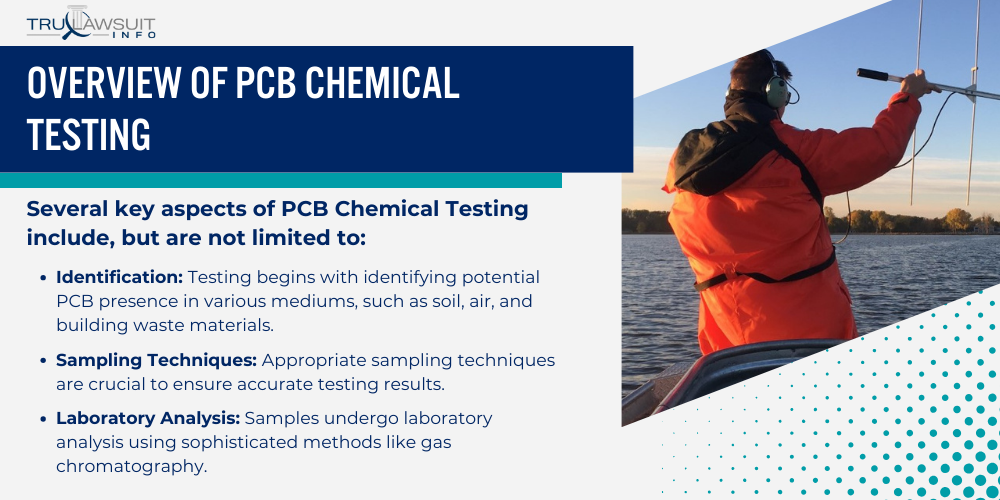
Introduction to PCB Chemical Testing
Polychlorinated biphenyls (PCBs) are synthetic chemicals that were once widely used in industrial and commercial applications due to their non-flammability, chemical stability, and insulating properties.
However, due to their environmental toxicity and tendency to accumulate in living organisms, their production was banned in many countries.
PCB chemical testing is essential for identifying the presence of these harmful compounds, particularly in areas at risk of contamination.
Several key aspects of PCB Chemical Testing include, but are not limited to:
- Identification: Testing begins with identifying potential PCB presence in various mediums, such as soil, air, and building waste materials.
- Sampling Techniques: Appropriate sampling techniques are crucial to ensure accurate testing results.
- Laboratory Analysis: Samples undergo laboratory analysis using sophisticated methods like gas chromatography.
- Results Interpretation: Experts interpret the concentration levels of PCBs to assess the extent and potential contamination risks.
Steps in the PCB Testing Process
- Collecting representative samples from suspected areas following established protocols.
- Transporting samples to the laboratory while preventing cross-contamination.
- Extracting PCBs from the bulk solid samples using chemical solvents.
- Analyzing the extracts using equipment designed to detect and quantify PCBs.
- Comparing the levels found with regulatory standards to determine if action is needed.
- Reporting the findings to the relevant authorities or stakeholders for decision-making.
Industries and environmental agencies adhere to stringent testing procedures to ensure that the harmful effects of polychlorinated biphenyls do not compromise public health and environmental safety.
Advances in PCB Testing Technology for Improved Detection
The landscape of polychlorinated biphenyls (PCBs) testing has evolved with technology, offering scientists enhanced methods for detecting and analyzing these toxic chemical compounds.
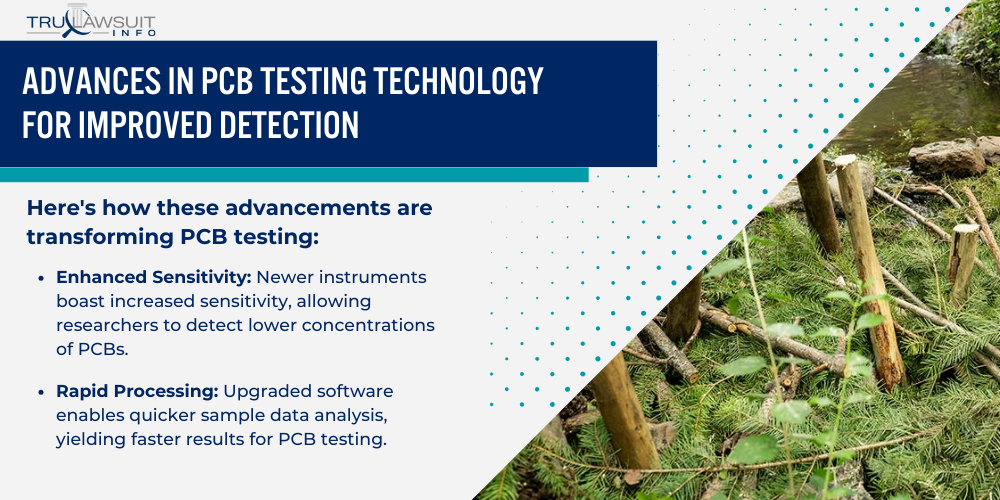
New Innovations in PCB Testing Equipment and Software
Advancements in equipment and software are redefining the approach to PCB analysis.
These innovations provide more substantial data and insights into the presence of PCBs, especially within environmental samples.
Here’s how these advancements are transforming PCB testing:
- Enhanced Sensitivity: Newer instruments boast increased sensitivity, allowing researchers to detect lower concentrations of PCBs.
- Rapid Processing: Upgraded software enables quicker sample data analysis, yielding faster results for PCB testing.
- Automation: High-throughput systems have enabled laboratories to process larger volumes of samples with greater accuracy.
- Data Management: Improved databases and software can better handle the complex data associated with PCB congeners and commercial PCB mixtures.
How Advanced PCB Testing Enables More Precise Analysis
Improved technology permits a more precise and detailed examination of PCBs.
Identifying specific PCB congeners in complex mixtures heightens our understanding of contamination profiles and sources.
Benefits of Advanced PCB Testing:
- Accurate Identification: Modern equipment accurately identifies individual PCB congeners in core samples.
- Quantitative Analysis: Enhanced precision in quantifying PCBs ensures reliable data for evaluating pollution and health risks.
- Greater Specificity: Advanced techniques can differentiate between PCBs and similar chemical compounds.
- Diverse Sample Types: Testing technology can now analyze various samples, from biota to sediments.
Best Practices for Implementing PCB Testing Procedures
Accuracy and safety are paramount in testing for polychlorinated biphenyls (PCBs).
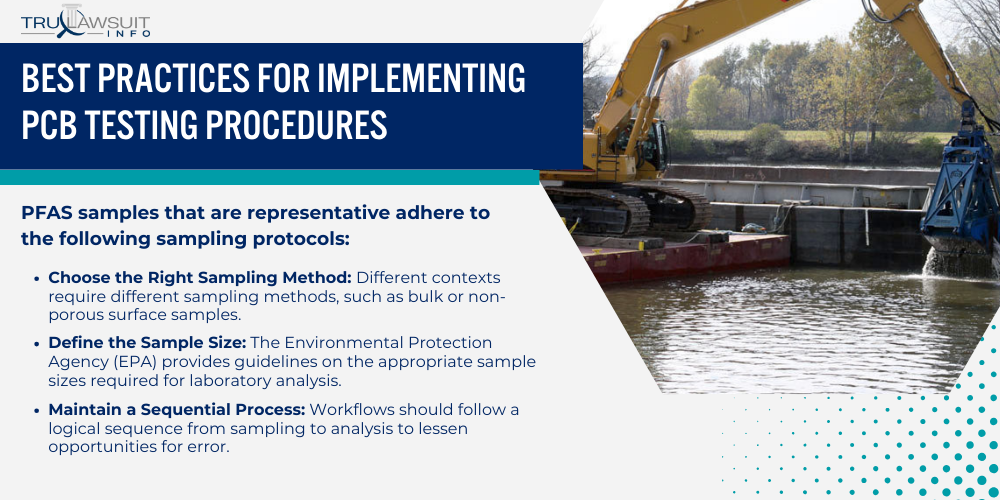
The following subsections summarize the best practices to ensure effective PCB testing, focusing on establishing sound protocols and thorough staff training.
Establishing Proper PCB Testing Protocols and Workflows
Establish detailed sampling protocols to prevent cross-contamination and ensure samples represent the site conditions.
To guarantee representative and uncontaminated samples, follow these detailed sampling protocols:
- Choose the Right Sampling Method: Different contexts require different sampling methods, such as bulk or non-porous surface samples.
- Define the Sample Size: The Environmental Protection Agency (EPA) provides guidelines on the appropriate sample sizes required for laboratory analysis.
- Maintain a Sequential Process: Workflows should follow a logical sequence from sampling to analysis to lessen opportunities for error.
- Ensure Clear Labeling and Documentation: Every sample should be labeled and accompanied by detailed records to trace its history.
- Utilize EPA-recommended Procedures: Adhering to the EPA’s guidance helps ensure compliance with regulatory standards.
- Review Protocols Regularly: Updating procedures in line with the latest EPA regulations and scientific advancements is essential.
Training Staff on Correct PCB Testing Methods & Analysis
A well-trained team is the backbone of reliable PCB testing operations.
To ensure a skilled and proficient workforce, implement the following strategies:
- Develop Comprehensive Training Programs: Formal training ensures staff are adept in both the theoretical and practical aspects of PCB testing and the use of equipment.
- Implement Ongoing Updates: Continuous education keeps staff current as regulations and best practices evolve.
- Emphasize Safety Practices: Staff should be well-versed in handling PCBs to protect themselves and the environment.
- Foster a Culture of Quality Control: Regular drills and peer reviews can help maintain a high testing accuracy and reliability standard.
By adhering to established protocols and investing in staff expertise, entities can confidently conduct PCB testing while safeguarding human health and environmental integrity.
Common Challenges in PCB Chemical Testing and How to Overcome Them
Chemical testing for Polychlorinated Biphenyls (PCBs) involves scrutinizing various sample locations for the presence of PCB molecules.
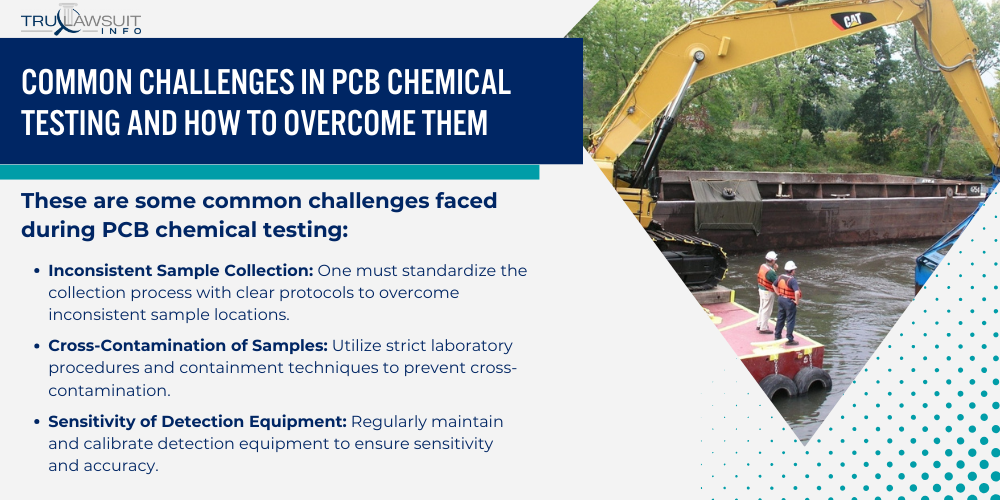
Test results provide crucial information; however, professionals must effectively address significant hurdles during the testing process.
Troubleshooting Issues That Arise During PCB Testing
Testing for PCBs is not without its issues, particularly when the test results seem inconsistent or unclear.
These are some common challenges faced during PCB chemical testing:
- Inconsistent Sample Collection: One must standardize the collection process with clear protocols to overcome inconsistent sample locations.
- Cross-Contamination of Samples: Utilize strict laboratory procedures and containment techniques to prevent cross-contamination.
- Sensitivity of Detection Equipment: Regularly maintain and calibrate detection equipment to ensure sensitivity and accuracy.
- Interpreting Complex Data: Invest in training for analysts to accurately interpret the complicated data associated with PCB testing.
Strategies to Streamline PCB Chemical Testing for Better Results
Reduce errors and improve efficiency by implementing a streamlined approach to PCB chemical testing.
This can be achieved by centralizing and automating sample processing to minimize human error and increase throughput.
To enhance the efficacy and accuracy of PCB testing, the following strategies can be deployed:
- Streamline Sample Processing: Centralizing and automating sample processing can reduce human error and improve throughput.
- Advanced Analytical Methods: Stay updated with and implement advanced analytical methods from authoritative sources like the Agency for Toxic Substances and Disease Registry to detect even low-level concentrations of PCBs.
- Robust Quality Control: Integrate rigorous quality control measures throughout the testing process to ensure the validity of test results.
- Continuous Training: Ensure personnel are trained on the latest testing protocols and equipment for consistent performance.
Future Trends and Developments in PCB Testing Approaches
The landscape of Polychlorinated Biphenyls (PCBs) testing is rapidly evolving to meet the challenges posed by these persistent organic pollutants in various municipal and industrial incinerators.
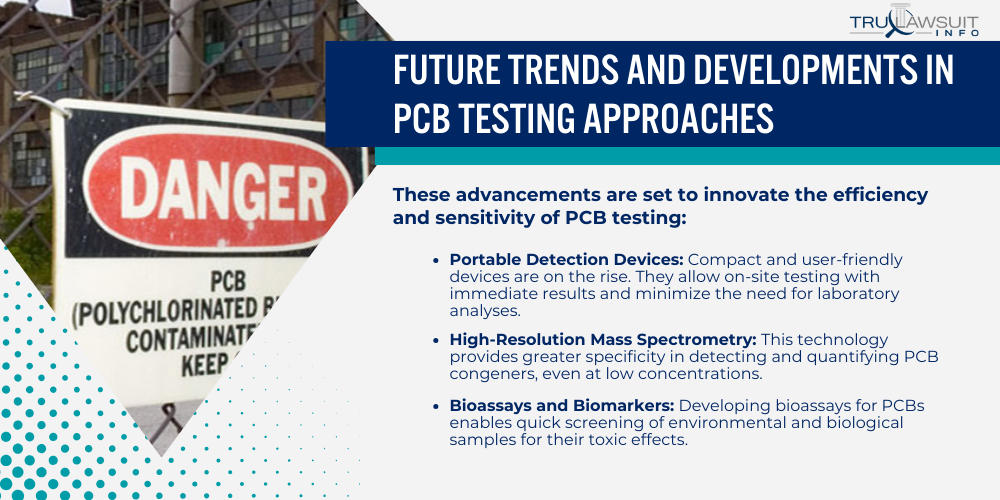
Advancements in technology and methodologies are paving the way for more precise and efficient testing processes.
Emerging Technologies Poised to Enhance PCB Testing
Emerging technologies are pivotal in improving the detection and analysis of PCBs.
These advancements are significant, and set to transform the efficiency and sensitivity of PCB testing:
- Portable Detection Devices: Compact and user-friendly devices are on the rise. They allow on-site testing with immediate results and minimize the need for laboratory analyses.
- High-Resolution Mass Spectrometry: This technology provides greater specificity in detecting and quantifying PCB congeners, even at low concentrations.
- Bioassays and Biomarkers: Developing bioassays for PCBs enables quick screening of environmental and biological samples for their toxic effects.
- Nano-Enabled Sensors: Nanotechnology enhances the detection of PCBs, making sensors more sensitive and capable of recognizing specific types of PCBs.
Preparing for Next-Generation PCB Chemical Testing Capabilities
The rise of PCB mixtures and stricter environmental regulations necessitates advancements in testing methodologies.
These new methods will improve detection limits and provide a more nuanced understanding of PCB contamination.
As the field of PCB testing advances, laboratories and researchers are gearing up to integrate new methods that address the demands of both environmental safety and regulatory compliance:
- Automation of Sample Preparation: Reduces human error and increases throughput, leading to more consistent and accurate results.
- Data Analytics and Machine Learning: Improved data processing techniques enable predicting PCB contamination patterns and identifying sources.
- Interdisciplinary Approaches: Combining chemistry, biology, and informatics for a holistic understanding of PCB impacts on health and the environment.
- Regulatory Adaptation: As new methods are validated, regulations must adapt to incorporate these technologies into standard testing protocols.
Through these technologies, PCB chemical testing is becoming more streamlined, precise, and comprehensive, ensuring that monitoring these stubborn contaminants is more effective in safeguarding health and the environment.
Case Studies: Successful PCB Testing Detection & Analysis
In environmental safety, PCB testing represents a pivotal step toward safeguarding human health and the ecosystem.
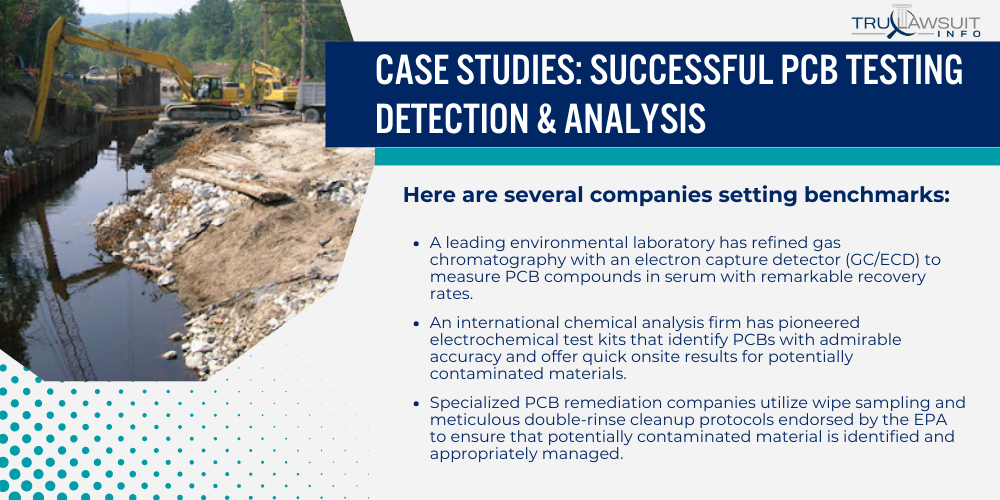
These case studies spotlight the precision and effectiveness of current methodologies in detecting and analyzing PCB contaminants.
Examples of Companies Excelling at PCB Testing Methods
Effective testing for PCBs is a testament to a company’s commitment to environmental stewardship.
Here are several companies setting benchmarks:
- A leading environmental laboratory has refined gas chromatography with an electron capture detector (GC/ECD) to measure PCB compounds in serum with remarkable recovery rates.
- An international chemical analysis firm has pioneered electrochemical test kits that identify PCBs with admirable accuracy and offer quick onsite results for potentially contaminated materials.
- Specialized PCB remediation companies utilize wipe sampling and meticulous double-rinse cleanup protocols endorsed by the EPA to ensure that potentially contaminated material is identified and appropriately managed.
- Innovative testing facilities have collaborated in inter-laboratory studies to bolster the precision of PCB serum analysis, fostering confidence in the detection methods and the resulting data.
Lessons Learned from Top-Notch PCB Testing Initiatives
Lessons from industry leaders in PCB testing reveal the importance of thorough planning and rigorous analysis.
Notable takeaways include:
- Authenticating the precision of PCB analysis demands comprehensive inter-laboratory collaboration and peer review.
- Critical to identifying PCB compounds is the employment of advanced technologies like GC/ECD, ensuring the fidelity of test results.
- Management of potentially contaminated materials relies on robust testing protocols that categorize materials based on PCB concentration, influencing disposal or remediation strategies.
- Continuous evolution of analysis methods is essential, as it improves detection and enhances safeguards against health and ecological risks.
Addressing Common Concerns Regarding PCB Testing Tools
Accurate results require the use of effective tools and methods when testing for polychlorinated biphenyls (PCBs).
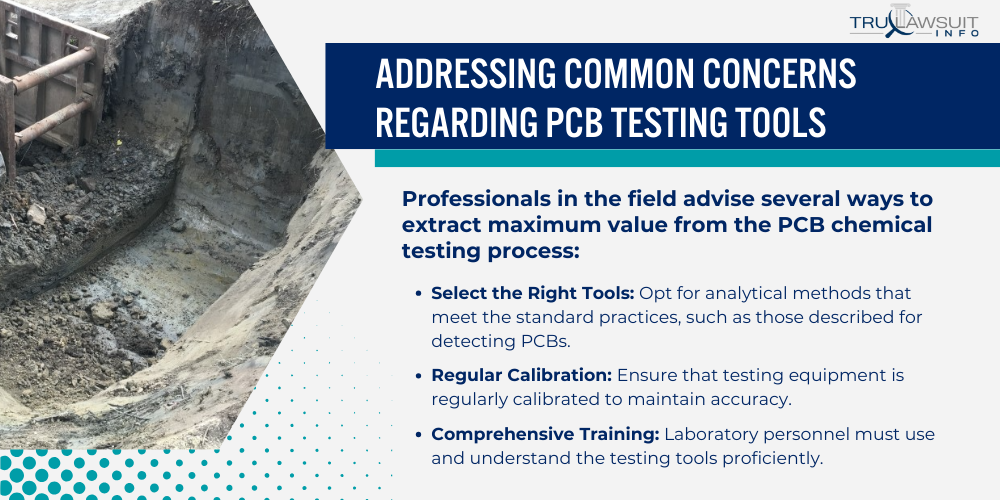
Expert Advice on Maximizing Value of PCB Chemical Testing Process
Bold styling is used for emphasis.
Professionals in the field advise several ways to extract maximum value from the PCB chemical testing process:
- Select the Right Tools: Opt for analytical methods that meet the standard practices, such as those described for detecting PCBs.
- Regular Calibration: Ensure that testing equipment is regularly calibrated to maintain accuracy.
- Comprehensive Training: Laboratory personnel must use and understand the testing tools proficiently.
- Proactive Maintenance: Implement a routine maintenance schedule to prevent unexpected equipment failures.
These steps help minimize the error margin, leading to more reliable detection of PCBs in various media.
Importance of Accurate PCB Testing for Quality Control
Accurate PCB testing is the cornerstone of responsible environmental management and public health protection.
It plays a critical role in safeguarding ecosystems, ensuring the safety of our food supply, and upholding legal regulations.
Precise PCB testing is vital for several reasons:
- Protecting Public Health: Inaccurate testing could underestimate adverse health effects due to undetected PCB exposure.
- Environmental Impact: Ensuring ecosystems’ safety requires accurately identifying contaminated fish and other wildlife.
- Economic Consequences: False negatives can have severe economic implications, especially in the fishing industry.
- Legal and Regulatory Compliance: Accurate testing ensures compliance with environmental regulations.
By recognizing these factors, stakeholders can help mitigate the health risks associated with eating contaminated fish and ensure the well-being of humans and the environment.
Frequently Asked Questions
-
Various analytical techniques are employed to determine PCB levels in water, including gas chromatography with electron capture detection (GC/ECD) and gas chromatography-mass spectrometry (GC-MS).
These methods are sensitive and specific for PCB detection and quantification.
-
One can contact state environmental agencies or search for environmental laboratories certified in PCB analysis.
These facilities are typically accredited and adhere to state and federal regulations for PCB testing.
-
Standard procedures for PCB testing usually involve sample collection, extraction, cleanup, and analysis phases.
The U.S. Environmental Protection Agency (EPA) provides guidelines and approved methods for these procedures.
-
Several commercial testing kits are available for preliminary screening of PCBs in environmental samples.
These kits often employ immunoassay or similar rapid screening methods but should be followed by more definitive laboratory analysis.
-
The cost of PCB chemical testing can vary widely depending on the complexity of the test, the sample matrix, and the level of detail required in the results.
It is best to consult with a testing facility for accurate pricing.
-
Results from a PCB chemical test are interpreted against regulatory limits or guidance values, which can differ based on the intended use of the water or land.
Understanding the units of measure and comparison values is critical for proper interpretation.

Attorney Jessie Paluch, founder of TruLawsuit Info, has over 25 years of experience as a personal injury and mass tort attorney, and previously worked as an international tax attorney at Deloitte. Jessie collaborates with attorneys nationwide — enabling her to share reliable, up-to-date legal information with our readers.
Legally Reviewed
This article has been written and reviewed for legal accuracy and clarity by the team of writers and legal experts at TruLawsuit Info and is as accurate as possible. This content should not be taken as legal advice from an attorney. If you would like to learn more about our owner and experienced injury lawyer, Jessie Paluch, you can do so here.
Fact-Checked
TruLawsuit Info does everything possible to make sure the information in this article is up to date and accurate. If you need specific legal advice about your case, contact our team by using the chat on the bottom of this page. This article should not be taken as advice from an attorney.
You can learn more about the PCB Exposure Lawsuit by visiting any of our pages listed below:
Here, at Tru Lawsuit Info, we’re committed to helping victims get the justice they deserve.
To do this, we actively work to connect them with attorneys who are experts in litigating cases similar to theirs.
Table of Contents
Tru Lawsuit Info is a reliable source of information about issues that may affect your health and safety, such as faulty products, data breaches, and environmental hazards.
Our team of experienced writers collaborates with medical professionals, lawyers, and advocates to produce informative articles, guides, and other resources that raise awareness of these topics.
Our thorough research provides consumers with access to reliable information and updates on lawsuits happening around the country. We also can connect consumers with attorneys if they need assistance.
Here, at Tru Lawsuit Info, we’re committed to helping victims get the justice they deserve.
To do this, we actively work to connect them with attorneys who are experts in litigating cases similar to theirs.
